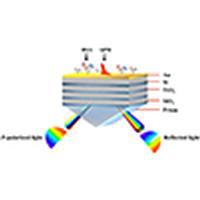当前位置:
X-MOL 学术
›
Photonics Res.
›
论文详情
Our official English website, www.x-mol.net, welcomes your feedback! (Note: you will need to create a separate account there.)
Photonic cavity enhanced high-performance surface plasmon resonance biosensor
Photonics Research ( IF 7.6 ) Pub Date : 2020-03-06 , DOI: 10.1364/prj.382567 Gui-Shi Liu , Xin Xiong , Shiqi Hu , Weicheng Shi , Yaofei Chen , Wenguo Zhu , Huadan Zheng , Jianhui Yu , Nur Hidayah Azeman , Yunhan Luo , Zhe Chen
Photonics Research ( IF 7.6 ) Pub Date : 2020-03-06 , DOI: 10.1364/prj.382567 Gui-Shi Liu , Xin Xiong , Shiqi Hu , Weicheng Shi , Yaofei Chen , Wenguo Zhu , Huadan Zheng , Jianhui Yu , Nur Hidayah Azeman , Yunhan Luo , Zhe Chen

|
Herein we propose a novel strategy to enhance surface plasmon resonance (SPR) by introducing a photonic cavity into a total-internal-reflection architecture. The photonic cavity, which is comprised of a highly reflective photonic crystal (PC), defect layers, and a gold (Au) film, enables Fabry–Perot (FP) resonances in the defect layers and therefore narrows the SPR resonance width in the metallic surface as well as increases the electric field intensity and penetration depth in the evanescent region. The fabricated sensor exhibits a 5.7-fold increase in the figure of merit and a higher linear coefficient as compared with the conventional Au-SPR sensor. The demonstrated PC/FP cavity/metal structure presents a new design philosophy for SPR performance enhancement.
中文翻译:

光子腔增强型高性能表面等离子体共振生物传感器
在此,我们提出了一种通过将光子腔引入全内反射结构来增强表面等离子体共振 (SPR) 的新策略。由高反射光子晶体 (PC)、缺陷层和金 (Au) 膜组成的光子腔使缺陷层中的法布里-珀罗 (FP) 共振成为可能,因此缩小了金属中的 SPR 共振宽度。表面以及增加衰减区域的电场强度和穿透深度。与传统的 Au-SPR 传感器相比,制造的传感器的品质因数增加了 5.7 倍,线性系数更高。所展示的 PC/FP 腔体/金属结构为 SPR 性能增强提供了新的设计理念。
更新日期:2020-03-06
中文翻译:

光子腔增强型高性能表面等离子体共振生物传感器
在此,我们提出了一种通过将光子腔引入全内反射结构来增强表面等离子体共振 (SPR) 的新策略。由高反射光子晶体 (PC)、缺陷层和金 (Au) 膜组成的光子腔使缺陷层中的法布里-珀罗 (FP) 共振成为可能,因此缩小了金属中的 SPR 共振宽度。表面以及增加衰减区域的电场强度和穿透深度。与传统的 Au-SPR 传感器相比,制造的传感器的品质因数增加了 5.7 倍,线性系数更高。所展示的 PC/FP 腔体/金属结构为 SPR 性能增强提供了新的设计理念。



























 京公网安备 11010802027423号
京公网安备 11010802027423号